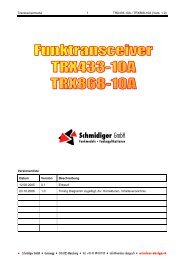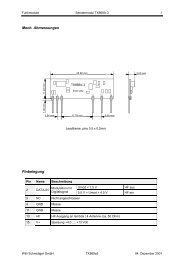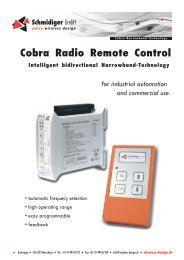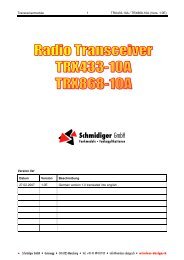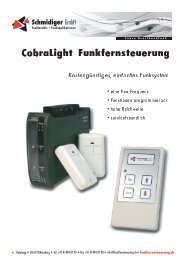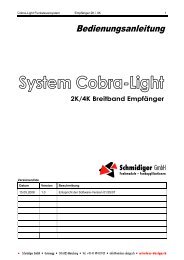Version List
Version List
Version List
Create successful ePaper yourself
Turn your PDF publications into a flip-book with our unique Google optimized e-Paper software.
Transceiver module TRX433-10C2 / TRX868-10C2 (Vers. 1.0E) 9<br />
CRC16<br />
The CRC16 is a 16-Bit check sum which checks the payloads in the DataField for correctnes. If the higher<br />
application doesn’t check the data then you should definitely use the CRC16.<br />
CRC16 off<br />
The radio data are not checked for correctness. The RS232 receives a data byte from the DataField of the<br />
radio telegram and outputs it immediately. The higher application has to deal with the checking of the data.<br />
CRC16 on<br />
The payloads in the DataField are CRC16-checksum-verified and the calculated checksum is included on<br />
the end of the radio telegram. That means that the data of the receiving transceiver module will only be<br />
output over RS232 when CRC16 corresponds. By wrong CRC16, the whole radio telegram will be rejected.<br />
Fast send<br />
The configuration Fast send decides when the radio transmission of the over the RS232 received payloads<br />
starts and in which way the radio telegram length is transmitted.<br />
Fast send off<br />
The data which were received in one piece over the RS232 are buffered in the transmittion buffer. As soon<br />
as no further data is received over the RS232 for the time of 2-3 RS232-bytes then the radio transmission<br />
starts and the current stored payloads in the transmittion buffer are transmitted. The length of the radio<br />
telegram is therefore defined at the beginning of the radio transmission (in the LengthField, the number of<br />
bytes of payloads are entered). When further data are received over RS232 during the radio transmission,<br />
they will be buffered in the transmittion buffer and they’ll build a new radio telegram as soon as the radio<br />
transmission of the current radio telegram is complete.<br />
Fast send on<br />
The radio transmission starts once the first byte is received over RS232 and will not stop until no byte is left<br />
in the transmittion buffer. Therefore the length of a radio telegram is not known in the beginning of the radio<br />
transmission. That’s why no LengthField is added to the radio telegram. To label the radio telegram length, a<br />
bit is added to every payload byte in the DataField which shows the end of the payloads.<br />
Note<br />
• Although the radio transmission starts earlier with Fast send than without, one bit is added to every<br />
payload byte in the DataField for the identification of the radio telegram length. Thereby, a radio telegram<br />
with fast send on and more than 8 bytes payload gets longer than one without fast send.<br />
• Due to the fact that Fast send means more computing effort, Fast send can only be used up to a RF data<br />
rate of 19.2kbits/s (respectively 9.6kbits/s by 8MHz µP clock frequency).<br />
• The radio telegram length is limited to 61 bytes with Fast send when CRC16 is enabled because the<br />
receiver has to buffer the whole radio telegram until CRC16 is checked. The user has to make sure that<br />
the length of the radio telegram is no more than 61 bytes payload.<br />
• With disabled CRC16 and Fast send on, a radio telegram length with over 61 bytes payload is possible.<br />
• The pause with the period of 2-3 RS232-bytes for the start of the radio transmission without Fast send<br />
varies depending on the adjusted configuration. To make sure that the radio transmission really will start<br />
you should keep a minimum pause of three RS232-bytes.



